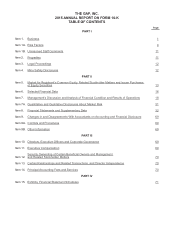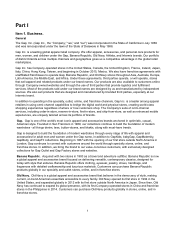Banana Republic 2015 Annual Report Download - page 18
Download and view the complete annual report
Please find page 18 of the 2015 Banana Republic annual report below. You can navigate through the pages in the report by either clicking on the pages listed below, or by using the keyword search tool below to find specific information within the annual report.9
The market for prime real estate is competitive.
Our ability to effectively obtain real estate - to open new stores, distribution centers, and corporate offices
nationally and internationally - depends on the availability of real estate that meets our criteria for traffic, square
footage, co-tenancies, lease economics, demographics, and other factors. We also must be able to effectively
renew our existing store leases. In addition, from time to time, we may seek to downsize, consolidate, reposition,
relocate, or close some of our real estate locations, which in most cases requires a modification of an existing
store lease. Failure to secure adequate new locations or successfully modify existing locations, or failure to
effectively manage the profitability of our existing fleet of stores, could have a material adverse effect on our
results of operations.
Additionally, the economic environment may at times make it difficult to determine the fair market rent of real
estate properties within the United States and internationally. This could impact the quality of our decisions to
exercise lease options at previously negotiated rents and the quality of our decisions to renew expiring leases at
negotiated rents. Any adverse effect on the quality of these decisions could impact our ability to retain real estate
locations adequate to meet our targets or efficiently manage the profitability of our existing fleet of stores and
could have a material adverse effect on our results of operations.
Our investments in omni-channel shopping initiatives may not deliver the results we anticipate.
One of our strategic priorities is to further develop an omni-channel shopping experience for our customers
through the integration of our store and digital shopping channels. Examples of our recent omni-channel initiatives
include our ship-from-store, reserve-in-store, and order-in-store programs. We continue to explore additional ways
to develop an omni-channel shopping experience, including further digital integration and customer
personalization. These initiatives involve significant investments in IT systems and significant operational
changes. In addition, our competitors are also investing in omni-channel initiatives, some of which may be more
successful than our initiatives. If the implementation of our omni-channel initiatives is not successful, or we do not
realize the return on our omni-channel investments that we anticipate, our operating results would be adversely
affected.
We experience fluctuations in our comparable sales and margins.
Our success depends in part on our ability to improve sales, in particular at our largest brands. A variety of factors
affect comparable sales or margins, including apparel trends, competition, current economic conditions, the timing
of new merchandise releases and promotional events, changes in our merchandise mix, the success of marketing
programs, foreign currency fluctuations, and weather conditions. These factors may cause our comparable sales
results to differ materially from prior periods and from expectations. Our comparable sales, including the
associated comparable online sales, have fluctuated significantly in the past on an annual, quarterly, and monthly
basis. Over the past fiscal year, our reported quarterly comparable sales have ranged from a high of negative 2
percent in the second and third quarters of fiscal 2015 to a low of negative 7 percent in the fourth quarter of fiscal
2015. Over the past five years, our reported gross margins have ranged from a high of 39.4 percent in fiscal 2012
to a low of 36.2 percent in fiscal 2015 and fiscal 2011. In addition, over the past five years, our reported operating
margins have ranged from a high of 13.3 percent in fiscal 2013 to a low of 9.6 percent in fiscal 2015.
Our ability to deliver strong comparable sales results and margins depends in large part on accurately forecasting
demand and apparel trends, selecting effective marketing techniques, providing an appropriate mix of
merchandise for our broad and diverse customer base, managing inventory effectively, using effective pricing
strategies, and optimizing store performance. Failure to meet the expectations of investors, securities analysts, or
credit rating agencies in one or more future periods could reduce the market price of our common stock and
cause our credit ratings to decline.
























